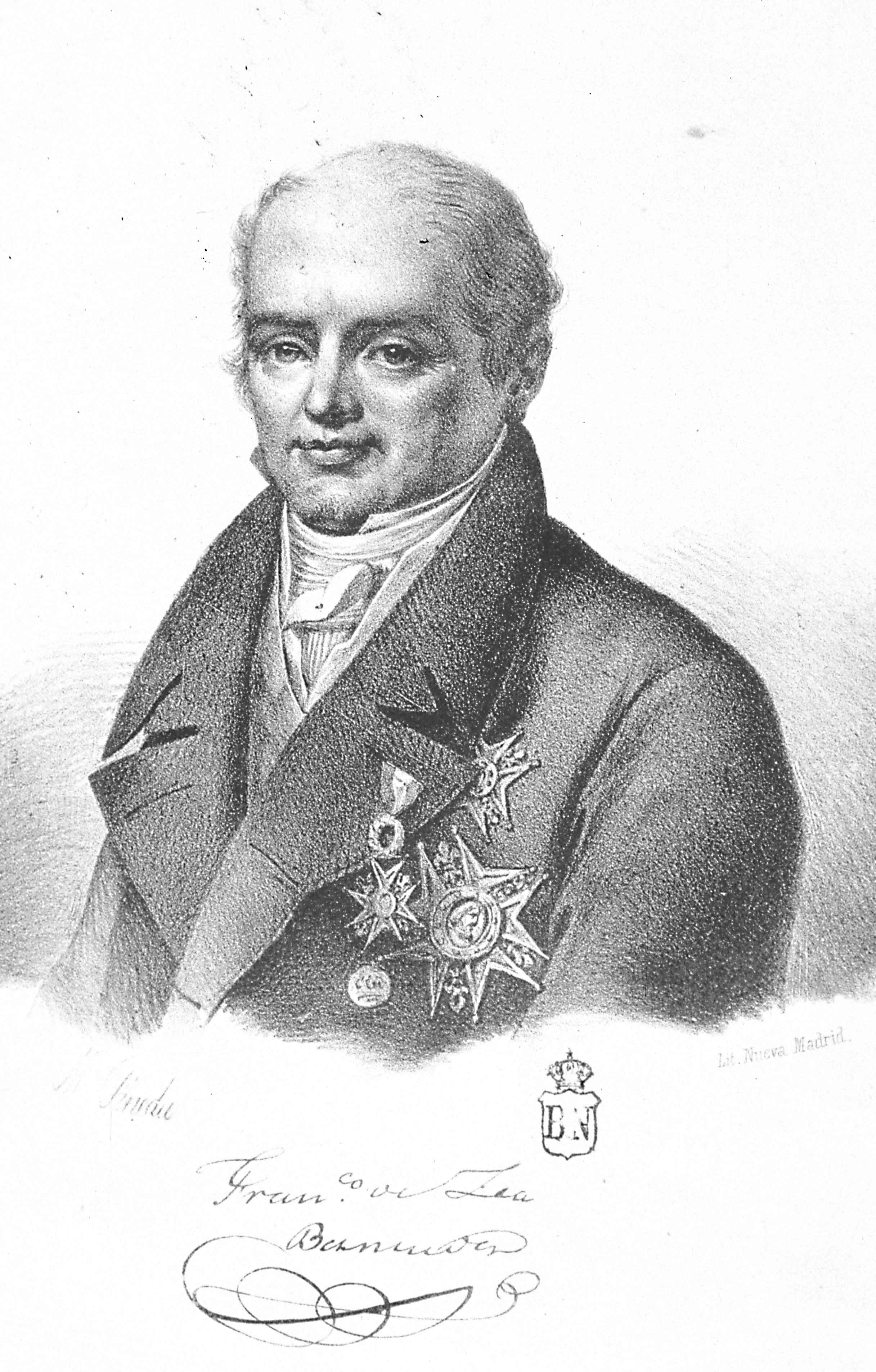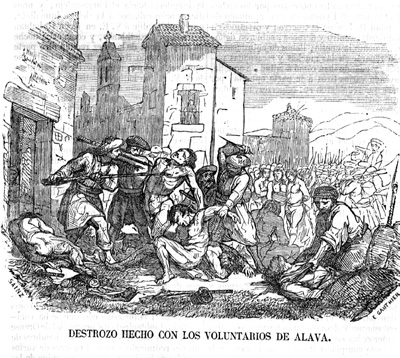|
Chapelgorris
Chapelgorris (; eu, txapelgorri, "Red Caps"), also called Peseteros, were a type of volunteer unit during the First Carlist War, raised at the beginning of the war in the province of Guipúzcoa. They fought against the Carlists. A soldier of the British Legion called them a "half-wild soldiery" who "possess the same knowledge of the country, with the war-like habits and activity of the Carlists themselves, by whom they are held in considerable dread."Charles William Thompson, ''Twelve months in the British legion, by an officer of the Ninth regiment'' (Oxford University, 1836), 10. The Chapelgorris were formed in battalions of 700-800 men, and were officered mainly by Basques. At first irregular troops, they were later considered a regular corps. They were called officially Free Troops (tropas francas) –for example, la ''Tropa franca de caballería de Ausejo'' (Free Troops of Cavalry of Ausejo) - but were disparagingly called ''Peseteros'' (which can be roughly translated as ... [...More Info...] [...Related Items...] OR: [Wikipedia] [Google] [Baidu] |
First Carlist War
The First Carlist War was a civil war in Spain from 1833 to 1840, the first of three Carlist Wars. It was fought between two factions over the succession to the throne and the nature of the Monarchy of Spain, Spanish monarchy: the conservative and devolutionist supporters of the late king's brother, Infante Carlos, Count of Molina, Carlos de Borbón (or ''Carlos V''), became known as Carlism, Carlists (''carlistas''), while the progressive and centralist supporters of the regent, Maria Christina of the Two Sicilies, Maria Christina, Minority of Isabella II of Spain#The regency of Maria Christina, acting for Isabella II of Spain, were called Liberals (''liberales''), ''cristinos'' or ''isabelinos''. It is considered by some authors the largest and most deadly civil war of the period. The Carlist forces were split in three geographically distinct armies: ('North'), and ('Catalonia'), which by and large operated independently from each other. Aside from being a war of succession ... [...More Info...] [...Related Items...] OR: [Wikipedia] [Google] [Baidu] |
Auñamendi Encyclopedia
The Auñamendi Encyclopedia is the largest encyclopedia of Basque Basque may refer to: * Basques, an ethnic group of Spain and France * Basque language, their language Places * Basque Country (greater region), the homeland of the Basque people with parts in both Spain and France * Basque Country (autonomous co ... culture and society, with 120,000 articles and more than 67,000 images. History Founded in 1958 by the Estornés Lasa brothers, Bernardo and Mariano. He began publishing in 1969 with the help of the Auñamendi publishing house. Since 1996, Eusko Ikaskuntza has taken over the task of digitizing, cataloging and putting it on the network. The new encyclopedia is based on the Auñamendi encyclopedia by Bernardo Estornés Lasa, which began in 1933 and whose first and last volumes were released in 1960 and 2008 respectively. There were 58 volumes. The contents of the Auñamendi Encyclopedia are generated by a large group of specialists in different subjects who guarantee ... [...More Info...] [...Related Items...] OR: [Wikipedia] [Google] [Baidu] |
Red Berets
The red beret is a military beret worn by many military, paramilitary, commando, and police forces and should not be confused with the maroon beret worn by airborne troops all around the world. Military police Red berets are worn by the military police of many NATO and Commonwealth of Nations militaries. * Military Police (Russia) - Russian Federation * Royal Military Police – Provost branch of the British Army * Royal Australian Corps of Military Police * Corps of Military Police – India * Sri Lanka Corps of Military Police * Canadian Forces Military Police * MH Katonai Rendészeti Központ (MH KRK) - Hungarian Defence Forces Military Police Center * Feldjäger – Military Police of the German ''Bundeswehr'' * Royal Military Police – Malaysian Military Police * Póilíní Airm – Irish Military Police Corps (Ireland) * Danish Military Police * Military Police – Kuwait Army * Namibian Defence Force Military Police * Royal Military Police – Jordan Armed Forces * ... [...More Info...] [...Related Items...] OR: [Wikipedia] [Google] [Baidu] |
Lord Eliot Convention
The Lord Eliot Convention, or simply the Eliot Convention or Eliot Treaty ( es, Convenio Lord Eliot), was an April 1835 agreement brokered by Edward Eliot, 3rd Earl of St Germans between the two opposing sides of the First Carlist War. It had as its aim not to end the war itself but to end the indiscriminate executions by firing squad that had been committed by both sides. Edward Eliot had become Secretary of Legation at Madrid on 21 November 1821 and was styled ''Lord Eliot'' in 1826. Executions During the First Carlist War, which began in 1833, Carlist prisoners who did not accept the Liberal Isabel II as their sovereign were executed by firing squad. Early Isabeline executions include that of Santos Ladrón de Cegama on October 14, 1833 at Pamplona. On December 4, 1833, Vicente Genaro de Quesada, captain-general of Old Castile, executed five Carlists by firing squad at Burgos. The prisoners were given four hours to prepare for death, though the archbishop of Burgos r ... [...More Info...] [...Related Items...] OR: [Wikipedia] [Google] [Baidu] |
First Battle Of Arquijas
The First Battle of Arquijas (December 15, 1834) was a battle of the First Carlist War. Opening shots The battle began when Liberal forces found Carlist general Tomás de Zumalacárregui waiting at the bridge of Arquijas over the Ega River in Navarre; about the middle of the day, some gunshots were exchanged between the several advanced posts.Louis Xavier Auguet de Saint-Sylvain, ''The career of don Carlos, since the death of Ferdinand the Seventh'' (Original from Oxford University, 1835), 264. Battle at the bridge The Liberals under Luis Fernández de Córdova attempted to force this bridge. The division of Cordova formed itself in order of battle near the hermitage of Arquijas (Ermita de Nuestra Señora de Arquijas), which commanded the rapids near the bridge. Artillery was stationed by the Liberals near this spot to protect the passage of the Liberal forces. A column of picked men, composed of carabiniers and '' peseteros'', attempted to cross the bridge. The Carlist Four ... [...More Info...] [...Related Items...] OR: [Wikipedia] [Google] [Baidu] |
Mutiny
Mutiny is a revolt among a group of people (typically of a military, of a crew or of a crew of pirates) to oppose, change, or overthrow an organization to which they were previously loyal. The term is commonly used for a rebellion among members of the military against an internal force, but it can also sometimes mean any type of rebellion against any force. Mutiny does not necessarily need to refer to a military force and can describe a political, economic, or power structure in which there is a change of power. During the Age of Discovery, mutiny particularly meant open rebellion against a ship's captain. This occurred, for example, during Ferdinand Magellan's journeys around the world, resulting in the killing of one mutineer, the execution of another, and the marooning of others; on Henry Hudson's ''Discovery'', resulting in Hudson and others being set adrift in a boat; and the notorious mutiny on the ''Bounty''. Penalty Those convicted of mutiny often faced capital punis ... [...More Info...] [...Related Items...] OR: [Wikipedia] [Google] [Baidu] |
Guías De Navarra
The Guías de Navarra (, "Navarre Guides") were a Carlist battalion of the First Carlist War, created by Zumalacárregui in 1834. Their name was a misnomer: they were neither Navarrese nor guides, but captured Liberal troops from La Mancha, Valencia, Andalusia and other places who had been made prisoners at the Battle of Alsasua (April 22, 1834). After this battle, they had been faced with the choice of joining the Carlist troops or being executed. They were given distinctive red berets that had initially been rejected by other Carlist troops as headgear. The Carlist troops had lacked a regular uniform and had used instead the black beret that was already worn in the Basque region. Zumalacárregui gave these troops distinctive red berets, purchased in France, as a type of uniform. At first, the red berets were accepted with joy by Carlist officers, but they then realized that Liberal sharpshooters found the red berets to be a good target. The red berets were thus retired a ... [...More Info...] [...Related Items...] OR: [Wikipedia] [Google] [Baidu] |
Carbine
A carbine ( or ) is a long gun that has a barrel shortened from its original length. Most modern carbines are rifles that are compact versions of a longer rifle or are rifles chambered for less powerful cartridges. The smaller size and lighter weight of carbines make them easier to handle. They are typically issued to high-mobility troops such as special operations soldiers and paratroopers, as well as to mounted, artillery, logistics, or other non-infantry personnel whose roles do not require full-sized rifles, although there is a growing tendency for carbines to be issued to front-line soldiers to offset the increasing weight of other issued equipment. An example of this is the U.S. Army's M4 carbine, which is standard issue. Etymology The name comes from its first users — cavalry troopers called "carabiniers", from the French ''carabine'', from Old French ''carabin'' (soldier armed with a musket), whose origin is unclear. One theory connects it to an "ancient engine of w ... [...More Info...] [...Related Items...] OR: [Wikipedia] [Google] [Baidu] |
Bandolier
A bandolier or a bandoleer is a pocketed belt for holding either individual bullets, or belts of ammunition. It is usually slung sash-style over the shoulder and chest, with the ammunition pockets across the midriff and chest. Though functionally similar, they are distinct from chest rigs, which are designed to hold magazines instead. History By the late 15th century, the earliest viable handheld firearms in Europe were the arquebus fitted with a matchlock mechanism. The user kept his shot in a leather pouch and his powder in a flask with a volumetric spout. The spout was calibrated to deliver the proper charge for the user's arquebus. With the advent of the heavy arquebus (later known as a musket) in the early 16th century, a spout large enough to measure the required powder was impractical. Furthermore, trying to double or triple charge from a flask was time consuming and could create a “missed” charge. A bandolier from whence would hang several little flasks each fil ... [...More Info...] [...Related Items...] OR: [Wikipedia] [Google] [Baidu] |

_02.jpg)


.jpg)
